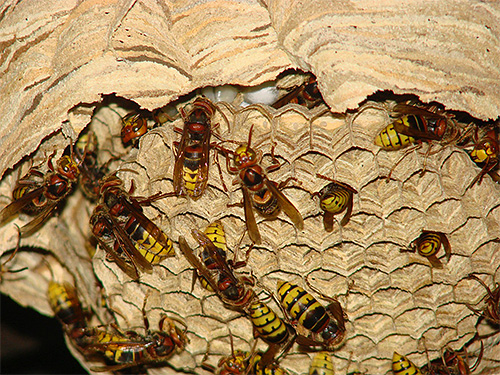
A nest of hornets in a summer cottage always represents a certain source of danger. It is believed that in order to guarantee the peaceful coexistence of man and hornets, you should not approach their nest closer than 50 meters. But in most summer cottages, this condition is simply not feasible, which means that it is still desirable to remove the hornet nest, and the sooner the better.
In the photo - a nest of hornets above the entrance to the utility room. In this case, access to such a room is always associated with a health risk:


In general, hornets guard their nest very diligently and, when signs of danger, are sharply activated (this must be borne in mind when you try to remove it). However, at a great distance from the nest, the hornet may well seem to be a relatively peaceful insect, as it will always prefer to fly away in case of danger.
Thus, settling in summer cottages, these large insects at least deliver tangible inconvenience to their owners. It often happens that a person has to experience a hornet bite.

Hornet bites are very painful.In most cases, they lead to severe swelling and long throbbing pain. But that's not all: in some cases, when the victim has an increased sensitivity to insect bites, a hornet attack can lead to the development of severe, rapidly spreading, life-threatening allergy symptoms. If a person is not provided with qualified medical assistance in time, then for him a meeting with a hornet can result in anaphylactic shock and even death (in rare cases).
This problem is very relevant for the inhabitants of Primorye and the countries of Southeast Asia, where the giant Asian hornet lives.
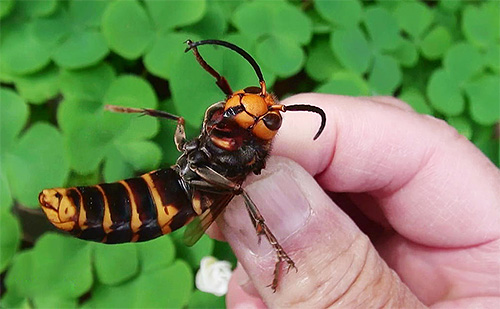
However, his ordinary European counterparts can be very dangerous.
Especially often, beekeepers have to think about how to destroy the hornet's nest. The fact is that in addition to the inconvenience caused to ordinary summer residents and gardeners, these insects are very harmful to beekeeping: they prey on bees that they feed, including their larvae, thereby seriously reducing the number of honey families. Sometimes, flying in masses, a relatively small detachment of hornets in just a few hours can destroy a multi-thousand bee colony.
The photo below shows huge Japanese hornets attacking a bee hive:
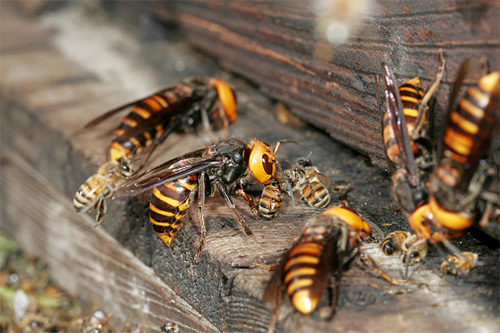
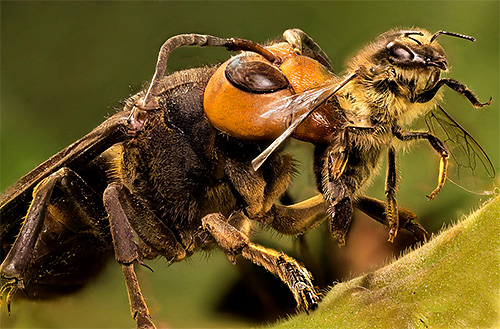
Important!
Due to the constant persecution by man and the thoughtless destruction of dwellings, hornets have become rare in many regions of our country, and in some places they are even listed in the Red Book. Therefore, hornet nests should be destroyed only when they create serious problems for economic activity or pose a threat to human health.
The hornet's nest and its inner life
A free-hanging hornet nest looks like a rather bulky light gray structure. Outwardly, it resembles a large fruit, the width of which can reach 40 cm, and the height - 70 cm.
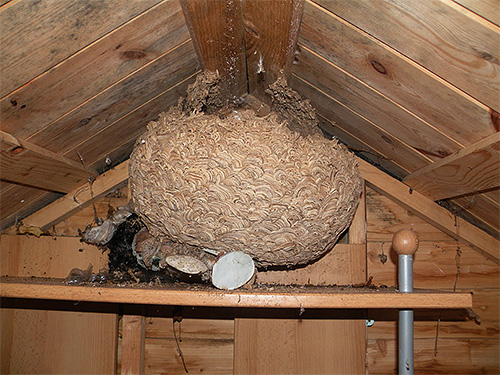
The hornet hive has a rather complex internal structure - it develops from several initial combs built by the founding female, around which subsequently the working hornets constantly build additional structures, finishing them on the outside.
The video below shows a nest of hornets and the constant fuss inside it:
This video shows how hornets behave inside their nest
A nest of winged predators is built from thin young tree bark, which workers chew and mix with saliva. The result is a soft and plastic mass, reminiscent of wet paper, from which honeycombs or nest walls are molded.

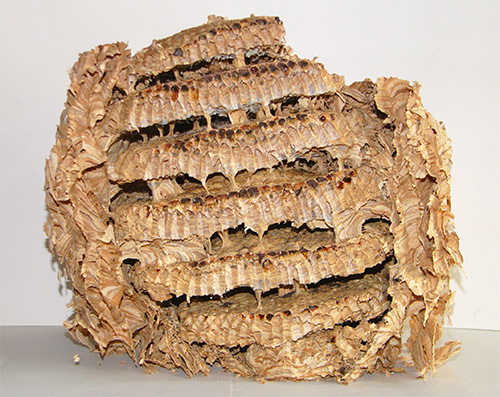
It is interesting
The noise that the hornets make with their jaws is clearly audible at a distance of several meters from the nest. In a large hive, several hundred workers can be engaged in such work at the same time.
In the photo - a nest of hornets at the stage of construction of the second tier of honeycombs. The first few houses for larvae and the top of the new wall are visible:

The uterus of hornets constantly moves between the tiers of the nest. The working individuals laying eggs are transferred and placed in combs, in which the larva will develop until it is completely transformed into an adult insect.

In the hornets nest there are separate floors connected by strong pendants.
Hornet larvae are carnivorous.If adult insects can sometimes eat fruits, honey, or aphid secretions, then their young feed exclusively on the meat of the prey they bring (usually these are small insects).
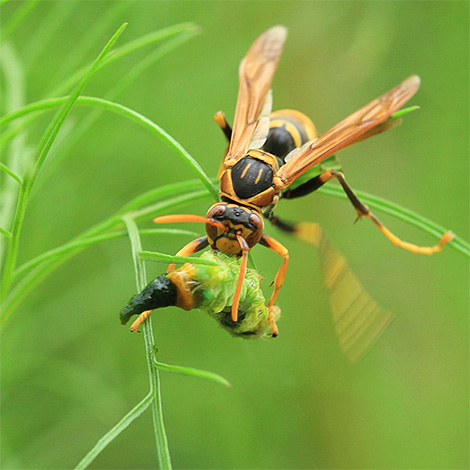
Before feeding the victim, the hornet cleans it of the chitinous shell, removes the limbs and head. It is not surprising that all this unused "garbage" accumulates under the hornet's nest. Often, various parasites start up in it, in which several generations are replaced in one season.
In the photo - a hive of hornets in cross section:

Hornets live in the nest only from spring to autumn. At the end of the season, all its inhabitants are already gone, in rare cases there are only a few wintering young queens that have not scattered in search of other shelters. It is this time that is considered the safest for removing and destroying the hornets' dwelling, since it often turns out to be empty at all.
Where to look for a nest?
Even if winged predators are frequent guests in a summer cottage or garden, it is not always clear where their nest is. This is especially true for apiaries, to which hornets often fly from the surrounding forest belts. In this case, before you fight with uninvited guests, you first need to find the place of their settlement.
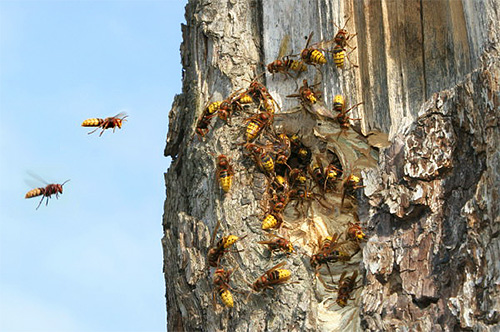
So how do you find a hornet's nest? The easiest way to do this is to observe the noticed insect: every few hours it will definitely return to its nest, and if it manages to catch a bee, this will happen immediately after a successful hunt.
However, you should not completely rely on your vision, because against the background of foliage and herbs, an insect can easily be lost sight of.It is better to do this: the noticed hornet is knocked down by a tennis racket and is already caught on the ground with a hand protected by a thick leather glove (this is necessary so that the insect does not sting). A well-marked ribbon or thread is put on the hornet's waist, which is slightly tied in a knot.
The photo below shows an example:

So, the predator is caught, the beacon is in place. After that, the insect can be safely released - now the hornet will most likely fly right into the nest, and the beekeeper, in turn, will be able to easily follow him and find his dwelling.
If the hornets literally flood the summer cottage, this can only mean one thing - their home is somewhere very close. In such cases, you can usually find a nest of hornets in the attics of household buildings, in the corners of sheds, behind various structures.
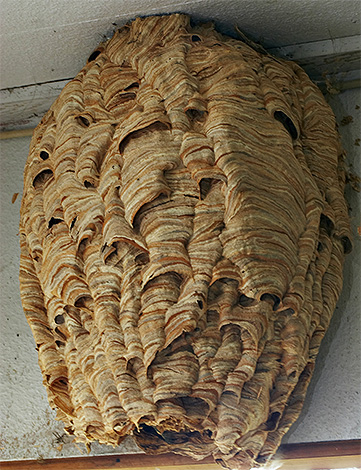
It should be noted that sometimes hornets can settle in earthen burrows. It is also possible to determine the location of their nest only as a result of observations.
Ways to destroy hornet nests
It just won’t work to remove the hornet’s nest - the insects will actively protect it and bite the “offender” even before he can reach the hive. Therefore, you need to clean the nest very carefully and competently.

There are several ways to get rid of hornets. Let's take a look at the most effective of them.
- Drown the nest with the hornets in the water. To do this, you do not need to remove the hive itself from the place where it hangs - just raise a bucket of water to it so that the entire nest is immersed in it. If it happens indoors, the task is even simpler - you don’t need to hold a container of water, you just need to press it against the ceiling, propping it up from below, for example, with a stepladder.
- Burn the hornet hive by spraying it with gasoline or kerosene. This is one of the simplest and most effective methods, which, however, can only be used when the nest is hanging on a non-combustible base and there is no danger of creating a fire by one's actions.
- Or you can spray a powerful insecticidal agent (Get, Lambda Zone, Delta Zone, Executioner, etc.) into a plastic bag and carefully wrap the nest around it.

An important feature of all these works is that it is desirable to start them at night, when the hornets are inactive and practically do not fly. And, of course, you need to follow certain safety rules (more on that below).
Review
“The hornets wound up in the attic, but for a long time we did not dare to climb there at all. But in vain. At first, the nest there was the size of a light bulb, and when there were so many of these monsters that they did not allow them to go out into the garden, the hive grew and became as big as a barrel. The husband once tried to climb into the attic and clean it, so the hornets began to buzz, and it was clear that they were about to attack. He got down from there, and went to poison them at night. He poisoned with Karbofos, and we diluted it weakly, so that it would certainly work. The whole nest had to be doused, then he ran away from there. Two days later I checked - the bulk of the hornets died, but there were still living ones. Processed again and finished off everyone. After that, the nest had to be sawn off with a hacksaw.”
Tatiana, Kostroma
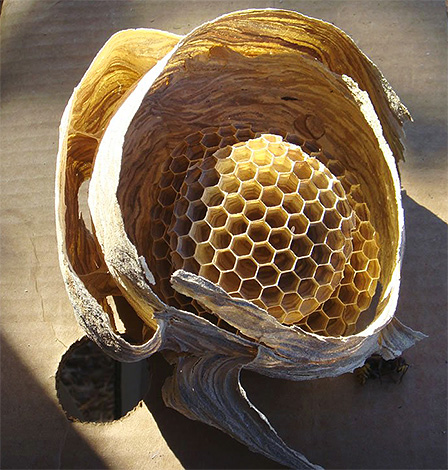
Another possible placement of insect dwellings is when their nest is in a hollow tree or in the ground. In the first case, you will need an insecticide, which should be poured into the hole at night, and putty to cover the entrance to the hollow.
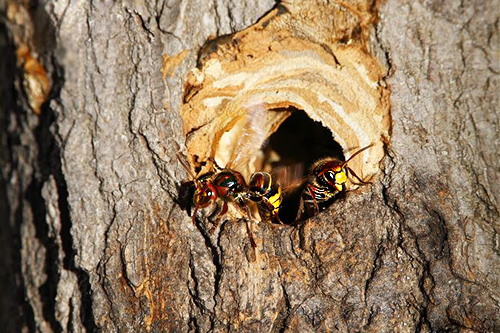
But the nest in the ground can simply be filled with boiling water.It is only important to remember that the home of the hornets can be very voluminous, and it will take a whole bucket or a large pot of boiling water to destroy it.
Observe safety precautions!
Whatever method of disposal is chosen by the owner of the site or apiary, the main thing is to remember that it is necessary to destroy the hornet nest very carefully. Even at night they do not sleep, they are simply inactive, but they are ready to start protecting their home at any moment. That is why for the operation you should choose clothes that completely cover the body, a beekeeper's mask and tight gloves.
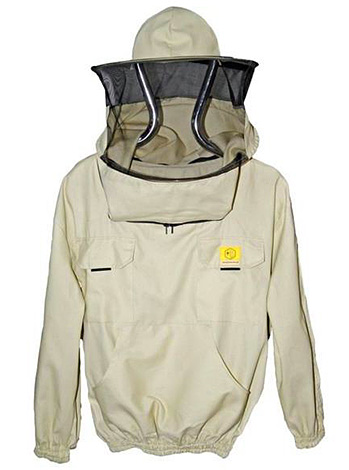
If it was not possible to quickly carry out the necessary manipulations, the hornets began to fly out of the nest and try to bite on clothes, you should calmly, without sudden movements, move to a safe distance.
Even before destroying the hornet nest, it is wise to prepare alcohol or peroxide to treat bites, a cold compress and Suprastin. Of course, it’s good if these funds are not needed at all, but, nevertheless, it’s worth it to insure and prepare for any outcome of events.
In the photo below - severe swelling after a hornet bite:
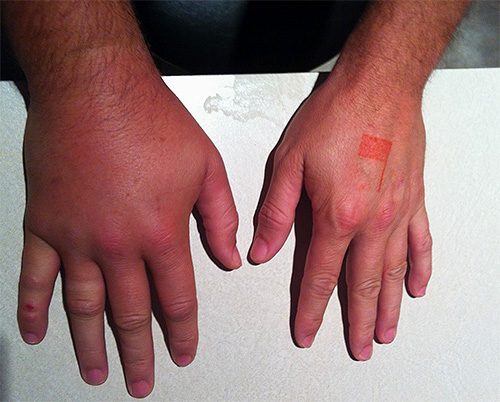
In the future, to prevent the construction of hornet nests in a summer cottage, at least in the beginning of spring, at least an inspection of all buildings should be carried out and cases of the appearance of these insects should be noted. If the first honeycombs with a founding queen are found somewhere, then you need to destroy them without delay, because at this stage, getting rid of is much easier and safer than it will be in a few months.
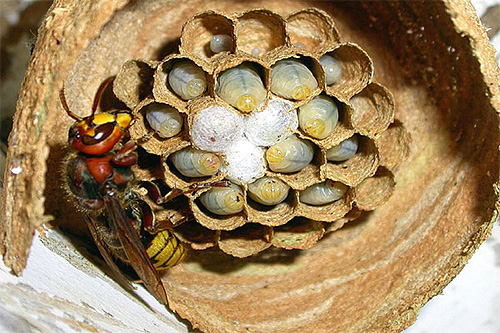
If the hornets in the country greatly interfere with the usual way of life or threaten health, they, of course, must be removed.However, there are also "ideal" cases when the hornet's nest is outside the site, and they fly to the garden or garden only to hunt. In this situation, it is not necessary to fight hornets - these insects will only help the owner of the garden, destroying pests.
Useful video: about hornet attacks on humans
The hornets were destroyed by aerosol, the nest was removed - you can see what its internal structure looks like ...

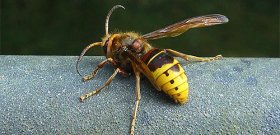
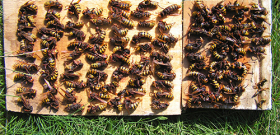
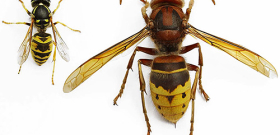
In my opinion, it is clear to everyone that when the hornet's uterus has already laid eggs in the nest, the larvae will begin to grow and the nest itself will become large, then it will be absolutely impossible to drive the hornets out of there safely. As far as my practice confirms (and I myself am a beekeeper and often faced with the dominance of hornets near the apiary), aggressive insects can bite and very seriously.I wonder if it is possible to try to divide the nest into parts and remove the hornet uterus along with one of these parts? Or is it only necessary to radically destroy all the hornets?
I have a nest of hornets in the attic of a residential building, like a bucket. I think in the winter, maybe cut it off with something and burn it. If the hornets, of course, winter there. And if not, then it's useless. Tell me, do hornets hibernate in their nest and is it worth removing it? ..
They do not overwinter in the nest.
They already wrote to you in the article: “At the end of the season, all its inhabitants are already absent, in rare cases there are only a few wintering young queens that have not scattered in search of other shelters.”
Removed the nest today, small, only 2 tiers. I tied a balloon of Dichlorvos on a 2-meter stick. Pshiknul 2 seconds, they fell down.
Wow, a huge hornet's nest!
The hornets are attacking!
Damn, I hate hornets myself, one bit me.
We called the Ministry of Emergency Situations, they removed the nest in a bag and we burned it. But the hornets have been flying around the house for two days now!
I have hornets flying all summer under the roof, I can’t see the nest, what to do - I don’t know! I'm afraid that all wooden structures, rafters, etc. will turn into dust. Has anyone experienced this? Advise!
Call the Ministry of Emergency Situations.
I discovered a nest of hornets in early August under the roof of a barn. At first it looked like a small cone.The hornets flew overhead at a safe distance for them and for us, but when two grappled hornets fell from the pear almost on my head, I had to think about how to remove these uninvited dangerous neighbors. I also blamed them for the fact that, apparently, they bite through the fruits of pears, and they rotted on the tree - half of the crop was gone. While I was gaining determination to destroy them, the nest grew to the size of a bucket, in which the queen of the hornets laid brood (pupae of future individuals). I decided that it's time to destroy them, because after the absence of feeding hornets, they will simply die. I decided to poison them with dichlorvos at night, when they are all in place. She put on three layers of clothes, a beekeeping mask, a hat on her head and thick gloves in order to protect herself from bites. I climbed into the attic with trembling hamstrings - they suddenly fly out and stick around as happened with bees. All my fears were in vain. The hornets were shocked that they were being poisoned, and no one bothered me. I doused their dwelling from all sides with an aerosol and the cocoon was filled with a terrible buzzing. I hurried to get off, as my head was spinning from the poison (there is no respirator). They buzzed for a long time, almost an hour, and in the morning the hornets lay dead or continued to writhe on the ground. So don't be afraid. Just do not turn on the light in the dark, they fly into the light. Do everything quietly and in the dark.
Hornets found shelter in the root of a sawn tree, how to destroy them?